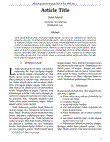Search Results - Arctic~
Suggested Topics within your search.
Suggested Topics within your search.
- México 135
- 122
- Nuevo León 98
- Monterrey 82
- literatura 78
- Educación 75
- educación 75
- Mexico 71
- cuento 56
- Innovación 52
- UANL 48
- sustentabilidad 47
- COVID-19 45
- Literatura 45
- redes sociales 44
- Covid-19 39
- comunicación 39
- estudiantes 39
- Preparatoria No. 3 37
- innovación 36
- derechos humanos 35
- educación superior 34
- democracia 33
- relato corto 33
- Presentación 32
- tecnología 32
- Competitividad 31
- I21 31
- Reseña de libro 31
- communication 31
-
81
Antibacterial and Antibiofilm Activity of Methanolic Plant Extracts against Nosocomial Microorganisms
Published 2016“…In the present study the antimicrobial and antibiofilm activities of 8 methanolic plant extracts were evaluated against clinical isolated microorganisms. …”
Get full text
Article -
82
Maternal eating and physical activity strategies and their relation with children's nutritional status
Published 2014“…The Parental Strategies for Eating and Activity Scale (PEAS) was applied and the child’s weight, height and BFP were measured. …”
Get full text
Article -
83
-
84
Antigiardial Activity of Foeniculum vulgare Hexane Extract and Some of Its Constituents
Published 2022“…Therefore, 20 constituents of hexane extract were evaluated to determine their antigiardial activity. Interestingly, six compounds showed good activity toward the parasite. …”
Get full text
Article -
85
Changes during the sleep onset process on EEG activity and the components of attention
Published 2022“…The sleep onset process (SOP) happens every time a person falls asleep, regardless of the time of day or if they are doing an activity. Basic cognitive processes, such as attention, differ between wakefulness and sleep. …”
Get full text
Article -
86
Production of biologically active human lymphotactin (XCL1) by Lactococcus lactis
Published 2009“…We expressed human lymphotactin (LTN) by the lactic-acid bacterium Lactococcus lactis. Biological activity of LTN was confirmed by chemo-attraction of human T-cells by chemotaxis demonstrating, for the first time, how this chemokine secreted by a food-grade prokaryote retains biological activity and chemoattracts T lymphocytes. …”
Get full text
Article -
87
Application of stable isotope analysis to differentiate shrimp extracted by industrial fishing or produced through aquaculture practices.
Published 2014“…Carbon and nitrogen stable isotope values were determined in Pacific white shrimp (Litopenaeus vannamei) with the objective of discriminating animals produced through aquaculture practices from those extracted from the wild. Farmed animals were collected at semi-intensive shrimp farms in Mexico and Ecuador. …”
Get full text
Article -
88
Assessment Practice in a Self-Access Language Learning Center at Universidad Autónoma de Nuevo León
Published 2017“…Finally, the fourth section states the findings observed, suggesting possible solutions, but focusing only in one (proposal), putting it into practice and discussing some recommendations for teachers in that specific context that might help others who encounter similar situations in their language classroom.…”
Get full text
Otro -
89
Path Analysis vs. SEM: A Practical Approach Using THE Model of HIV/AIDS Prevention in Adolescents
Published 2021Get full text
Sección de libro. -
90
Application of stable isotope analysis to differentiate shrimp extracted by industrial fishing or produced through aquaculture practices
Published 2014“…Carbon and nitrogen stable isotope values were determined in Pacific white shrimp (Litopenaeus vannamei) with the objective of discriminating animals produced through aquaculture practices from those extracted from the wild. Farmed animals were collected at semi-intensive shrimp farms in Mexico and Ecuador. …”
Get full text
Article -
91
Practical diets for Litopenaeus Vannamei (Boone, 1931): working towards organic and/or all plant production diets.
Published 2004“…In previous research we developed a practical diet formulation without fish meal but containing marine fish oil. …”
Get full text
Sección de libro. -
92
Practical Diets for Litopenaeus Vannamei (Boone, 1931): Working Towards Organic and/or All Plant Production Diets.
Published 2019“…Practical Diets for Litopenaeus Vannamei (Boone, 1931): Working Towards Organic and/or All Plant Production Diets.…”
Get full text
Article -
93
High-Level Expression of Recombinant Bovine Lactoferrin in Pichia pastoris with Antimicrobial Activity
Published 2016“…After Bach fermentation and purification by molecular exclusion, we obtained an expression yield of 3.5 g/L of rbLf. rbLf and predominantly pepsin-digested rbLf (rbLfcin) demonstrated antibacterial activity against Escherichia coli (E. coli) BL21DE3, Staphylococcus aureus (S. aureus) FRI137, and, in a smaller percentage, Pseudomonas aeruginosa (Ps. …”
Get full text
Article -
94
Green Synthesis of Silver Nanoparticles and Their Bactericidal and Antimycotic Activities against Oral Microbes
Published 2016“…Bactericidal and antimycotic activities of AgNPs were determined by Kirby and Bauer method and cell viability MTT assays. …”
Get full text
Article -
95
Antimycobacterial Activity of Constituents from Foeniculum vulgare Var. Dulce Grown in Mexico
Published 2012“…Compounds that showed some degree of antimycobacterial activity against all strains tested were the following: linoleic acid (MIC 100 µg/mL), oleic acid (MIC 100 µg/mL), 1,3-benzenediol (MIC 100–200 µg/mL), undecanal (MIC 50–200 µg/mL), and 2,4-undecadienal (MIC 25–50 µg/mL), the last being the most active compound. …”
Get full text
Article -
96
Virucidal and Synergistic Activity of Polyphenol-Rich Extracts of Seaweeds against Measles Virus
Published 2018“…In this study, we tested the antiviral activity against Measles virus (MeV)ofPolyphenol-richextracts(PPs)comingfromfiveseaweedscollectedandcultivatedinMexico. …”
Get full text
Article -
97
Vasodilator Activity of Compounds Isolated from Plants Used in Mexican Traditional Medicine
Published 2018“…Subsequently, involvement of the NO/cyclic guanosine monophosphate (cGMP) and H2S/ATP-sensitive potassium channel (KATP) pathways on the vasodilator activity of these compounds was assessed. The results derived from this analysis showed that the activation of both pathways contributes to the vasorelaxant effect of corosolic acid. …”
Get full text
Article -
98
Study of the immunogenicity of the cell death induced by the activation of CD47 in tumor cells
Published 2019“…CD47 activation by peptides derived from the C-terminal domain of thrombospondin-1, such as PKHB1, induces regulated cell death (RCD) in different types of cancer cells. …”
Get full text
Tesis -
99
Optics outreach activities with elementary school kids from public education in Mexico
Published 2023“…Several activities were realized through the 2011-2013 events with 1,600 kids with ages from 10 to 12; the results were analyzed using surveys. …”
Get full text
Article -
100
Antimycobacterial Activity of Hedeoma drummondii against Mycobacterium tuberculosis and Non-Tuberculous Mycobacteria
Published 2023“…The methanolic extract presented the best activity against M. tuberculosis, inhibiting ten of the twelve strains analyzed at a concentration < 2500 µg/mL; meanwhile, the hexanic extract presented the best activity against non-tuberculous mycobacteria (NTM) by inhibiting eight of the ten strains studied at ≤625 µg/mL. …”
Get full text
Article

